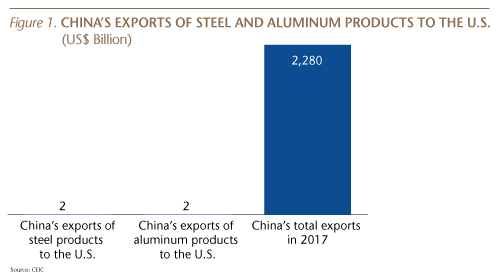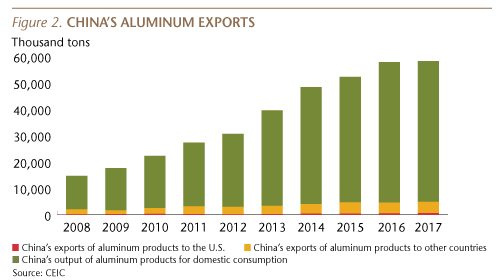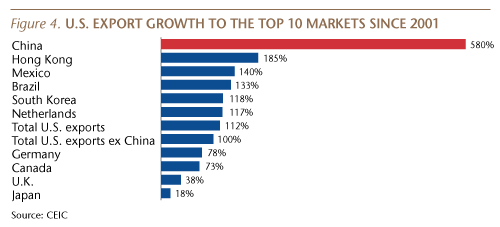Six False Premises: Trump, Steel and China
Trump's tariffs are based on these false premises. The result may be policies that will weaken both the U.S. economy and its foreign policy leadership.
President Donald Trump has at times declared that new tariffs supporting American steel and aluminum producers are necessary to protect national security, while at other times he has claimed they are a response to unfair practices by foreign governments. Unfortunately, these new taxes on U.S. imports are based on six false premises, and the result may be policies that will weaken both the U.S. economy and its foreign policy leadership. A trade war with Canada and the E.U. may be more likely than one with China.
False Premise 1: Massive overcapacity in China’s steel and aluminum industries has swamped the U.S. and global markets with subsidized metal.
In a recent report to President Trump, Commerce Secretary Wilbur Ross stated that “free markets globally are adversely affected by substantial chronic global excess steel production led by China,” and that “a major cause of the recent decline in the U.S. aluminum industry is the rapid increase in production in China. Chinese overproduction suppressed global aluminum prices and flooded into world markets.” This premise is inaccurate.
China does account for an astounding 50% of global steelmaking capacity, but it also accounts for 45% of global steel consumption, according to the World Steel Association.
In 2017, China’s steel exports were equal to only 7.2% of its total output of steel products, down from 9.6% in 2016 and a peak of 11% in 2007. The capacity utilization rate for Chinese steelmakers rose to 77% in the fourth quarter of 2017 from 73% a year ago. This indicates that the overcapacity problem is not dramatic and is in retreat, consistent with layoffs of more than 1 million workers over the last three years, equal to about a 25% reduction in China’s steel workforce.
It is also worth noting that according to Department of Commerce data, between 2011 and 2017, the volume of U.S. imports of steel from China declined by 31%, while total U.S. steel imports rose 38% and imports from Russia jumped 146%. (Russia accounted for 8% of total U.S. steel imports in 2017, compared to a 2% share for China.)
The situation for aluminum is similar. China accounts for 55% of global smelter capacity and 53% of primary aluminum consumption.
Last year, China’s exports of aluminum products were equal to about 7% of output, down from a peak of 15% in 2007.
In his report to Trump, Secretary Ross acknowledges that “one of the main reasons for the decline in U.S. primary aluminum production capacity is that the U.S. is a relatively high-cost producer. Because aluminum production is highly energy intensive, the world's leading producers are generally the countries with the lowest energy costs.”
False Premise 2: Tariffs on steel and aluminum imports will inflict enough pain on China’s economy that Beijing will change its policies.
Damage to the Chinese economy from these new tariffs will be trivial.
Last year, Chinese exports to the U.S. of steel and aluminum combined were worth only about US$4 billion, accounting for less than 0.2% of total Chinese exports and equal to only 0.03% of China’s GDP.

Even China’s steel and aluminum producers will barely notice the tariffs. Exports to the U.S. last year were equal to only 0.1% of China’s total steel production and 1% of total aluminum output. Last year, 57% of China’s steel exports went to the One Belt, One Road (OBOR) countries, where China is financing a wide range of infrastructure projects.

Moreover, China’s economy is no longer export-led. Last year, net exports of goods and services (the value of exports minus the value of imports) were equal to only 2% of China’s GDP. Consumption is the largest and fastest growing part of China’s economy.
This is why I expect China to respond to the tariffs in a measured and proportionate manner, as it did following Trump’s January decision to put high tariffs on imported solar panels. I do not expect Beijing to respond in a way that escalates into a “trade war.”
False Premise 3: The American steel industry is dying and needs protection from imports.
President Trump recently tweeted: “Our Steel and Aluminum industries are dead. Sorry, it’s time for a change! MAKE AMERICA GREAT AGAIN!”
But a February report by the Commerce Department on the steel industry paints a fairly positive picture of the health of the American steel industry—U.S. steel production rose 3.4% last year while capacity utilization was 73.9%, up from 70.5% in 2016.
The Commerce Department report also noted that since the first quarter of 2009, the six major American steel producers “collectively reported net earnings for 22 quarters” and “all steel stocks, except AK Steel and Nucor, outperformed compared to the S&P 500 between Q3 2017 and Q4 2017.”
U.S. Steel Corporation reported full-year 2017 net earnings of US$387 million, a significant turnaround from a full-year 2016 net loss of US$440 million. Nucor, one of the other major steel producers, reported consolidated net earnings of US$1.32 billion for fiscal 2017, up from US$796.3 million the prior year.
Employment in the U.S. steel industry has been in decline for many years, but much of this is due to improvements in productivity. I discussed this in a 2017 issue of Sinology:
"Productivity growth in the steel sector was one of the fastest in American manufacturing, according to a detailed analysis by economists at Duke and Princeton universities. “By 2000, the steel industry employed a fifth of the number of workers that it had in 1960, while production of steel went from 130 million tons in 1960 to 110 million tons in 2000. This implies that output per worker increased from 260 to 1,100 tons.”
False Premise 4: Imports of steel and aluminum threaten American national security.
President Trump recently tweeted that “To protect our Country we must protect American Steel!” Secretary Ross, in his report to the president, concluded that “present quantities and circumstances of steel imports are weakening our internal economy and threaten to impair the national security.” Ross made similar statements regarding aluminum.
Secretary of Defense Jim Mattis, however, disagrees. He recently explained to Ross that “U.S. military requirements for steel and aluminum each only represent about 3% of U.S. production. Therefore, DoD [Department of Defense] does not believe that the findings in the [Department of Commerce Section 232] reports impact the ability of [Department of Defense] programs to acquire the steel or aluminum necessary to meet national defense requirements.”
Significantly, 41% of U.S. steel imports come from countries with which the U.S. has collective defense agreements, including Canada (with a 16% share), South Korea, Japan, Germany and Turkey.

About 43% of U.S. aluminum imports come from Canada, and as Ross explained in his report, “The U.S. and Canadian defense industrial bases are integrated. This cooperative relationship has existed since 1956 and is codified in a number of bilateral defense agreements.”
In its most recent report to Congress on Annual Industrial Capabilities, published in June 2017, the Department of Defense said it “relies on an industrial base that is global, commercial and financially-complex. Overall, the defense industry remains viable and competitive. . . In general, globalization results in greater access to lower cost materials.” The word “steel” is not used once in the 116 page report.
The Wall Street Journal’s editorial board complained that “The national security threat from foreign steel is preposterous because China supplies only 2.2% of U.S. imports and Russia 8.7%. But the tariffs will whack that menace to world peace known as Canada, which supplies 16%.”
False Premise 5: Tariffs on steel and aluminum will not cause serious collateral damage.
Peter Navarro, one of Trump’s trade advisors, claims the new tariffs will result in “no downstream price effects on our industries that are significant,” and “I don’t believe any country in the world is going to retaliate for the simple reason that we are the most lucrative and biggest market in the world.” Commerce Secretary Ross says it is a “false assumption” that the tariffs will result in job losses in steel-consuming industries, “that's not the case at all.”
Well, recent history contradicts Navarro and Ross. In 2002, President Bush imposed tariffs on imports of some steel products for three years and one day. According to a study by the U.S. International Trade Commission, a government agency, during the first year those tariffs were in place, employment fell by 10% in firms producing carbon and alloy flat-rolled steel. Employment in the cold bar sector fell 11%, and firms producing steel rebar saw jobs fall by 2.7%.
A study published on March 5 by The Trade Partnership, a consulting firm, concludes that “the new tariffs would increase U.S. iron and steel employment and non-ferrous metals (primarily aluminum) employment by 33,464 jobs, but cost 179,334 jobs throughout the rest of the economy, for a net loss of nearly 146,000 jobs. More than five jobs would be lost for every one gained. Two thirds of the lost jobs affect workers in production and low-skill jobs.” This study did not take into account possible retaliation against U.S. exports.
Few issues unite a broad range of economists from both political parties, but opposition to these new tariffs is one of them. All 15 living former chairs of the White House Council of Economic Advisors, covering both Republican and Democratic administrations dating back to President Ford, recently signed a letter stating:
“Additional steel tariffs would actually damage the U.S. economy. Tariffs would raise costs for manufacturers, reduce employment in manufacturing, and increase prices for consumers. We urge you to avoid a policy that would likely incur greater economic and diplomatic costs than any conceivable national security gain.”
New Fed Chair Jerome Powell told Congress that he prefers direct assistance to workers affected by imports, “rather than falling back on tariffs.” And the president of the New York Fed added that “Trade barriers are a very expensive way to preserve jobs in less competitive or declining industries. Raising trade barriers would risk setting off a trade war, which could damage economic growth prospects around the world.”
Republican House speaker Paul Ryan said he is “extremely worried about the consequences of a trade war” and urged Trump to reconsider the tariffs.
The editorial board of the Wall Street Journal, usually supportive of President Trump, called his tariff plan “the biggest policy blunder of his presidency.” “This tax increase will punish American workers, invite retaliation that will harm U.S. exports, divide his political coalition at home, anger allies abroad, and undermine his tax and regulatory reforms.”
Several foreign leaders have threatened to retaliate against U.S. exports. According to The Wall Street Journal, “The E.U. first plans levies totaling US$3.5 billion on U.S. agriculture, steel and industrial products, as well as iconic American products including Harley Davidson motorcycles, Levi’s jeans and bourbon whiskey. . . The E.U. hopes to erode support for Mr. Trump’s policies by taking its fight to his allies’ constituencies. Roughly 95% of all bourbon comes from Kentucky, home of Senate majority leader Mitch McConnell, a Republican. House Speaker Paul Ryan is a Republican from Wisconsin, home to Harley Davidson.”
“It’s actually a stupid process that we must to do this, but we have to,” European Commission President Jean-Claude Juncker said Friday in response to Mr. Trump’s announcement. “We can also do stupid.”
The most significant consequences of the reaction to the Trump tariffs by U.S. allies may be political, rather than economic, if this leads those nations to look elsewhere for leadership on global trade and financial infrastructure.
It is worth recalling that the General Agreement on Tariffs and Trade (GATT), the predecessor to the WTO, was founded in 1947 as a way to reduce the risks of international conflict. As a history of GATT by the Brookings Institution explains:
At the conclusion of World War II, 23 countries, led primarily by the United States, Canada, and the United Kingdom, negotiated the General Agreement on Tariffs and Trade. The goal was to create an agreement that would ensure postwar stability and avoid a repeat of the mistakes of the recent past, including the Smoot-Hawley tariffs and retaliatory responses, which had been a contributor to the devastating economic climate that culminated in the death and destruction of the Second World War.
Given the substantial rise in wealth in the U.S. since that time, and its leadership role within global institutions setting the framework for trade and financial flows, the GATT/WTO process seems to have had a degree of success.
False Premise 6: Participation in the WTO has been bad for the U.S. economy.
On March 4, President Trump defended the use of unilateral tariffs, tweeting: “We are on the losing side of almost all trade deals. Our friends and enemies have taken advantage of the U.S. for many years.”
Not everyone in the White House, apparently, agrees.
The Council of Economic Advisers (CEA), an agency within the Executive Office of the President, says that the U.S. is usually on the winning side in the WTO. In its annual report, submitted to Congress in February, the CEA states that “The United States gets better outcomes via formal WTO adjudication than negotiation . . . the United States has won 85.7% of the cases it has initiated before the WTO since 1995 . . . In contrast, China's success rate is just 66.7%.”
The CEA report also points out that “trade and economic growth are strongly and positively correlated. . . This increasing economic reliance on trade makes trade policy critical to the future economy. It also means that the health of the global economy now matters more to the U.S. economy than it did historically; rising GDP among our trading partners promotes U.S. export growth.”
And the president’s economic advisors discourage an obsession on trade deficits, noting that the current account balance “reflects the excess of domestic savings over domestic investment” and that “policies that try to affect the trade balance without considering the broader current account balance, or vice versa, will be hard-pressed to succeed in the long run.”
“Fiscal and monetary policies may be more important than trade policies in determining the magnitude of trade balances . . . [and] focusing only on the trade in goods alone ignores the United States' comparative advantage in services, which rose as a share of U.S. exports to 33.5% through 2017:Q3.”
Finally, a quick reminder that China’s 2001 entry into the WTO has delivered benefits to a wide range of both Americans and Chinese.
China’s inclusion in the WTO has been a boon to many American companies. During the 16-year period when U.S. exports to China rose by 580%, our exports to the rest of the world were up by only 100%.

Exports to China are especially important to American farmers. China is their largest overseas market and since China’s WTO accession, the value of U.S. agricultural exports to China has risen by 1,000%. Shipments of American soybeans, for example, rose 13 times.
To sum up, there seem to be two prospects for the tariff issue, neither of which is great. One is that Trump proceeds with plans to tax imports of steel and aluminum from all producing countries. This will avoid a clash with China but will precipitate retaliation and anger from American allies. The second prospect is that Trump exempts U.S. allies—the major sources of imports of those metals—from the taxes and focuses on China, a minor source. This won’t lead to a trade war, but Beijing will respond in a proportionate way, probably by curbing imports of American soybeans, in the hope that Midwestern farmers will mark their displeasure at the ballot box in November’s mid-term elections.
Andy Rothman
Investment Strategist
Matthews Asia
Sources: CEIC and China’s National Bureau of Statistics unless otherwise noted.
As of March 6, 2018, accounts managed by Matthews Asia did not hold positions in Nucor Corporation, AK Steel Holding Corporation or U.S. Steel Corporation.
